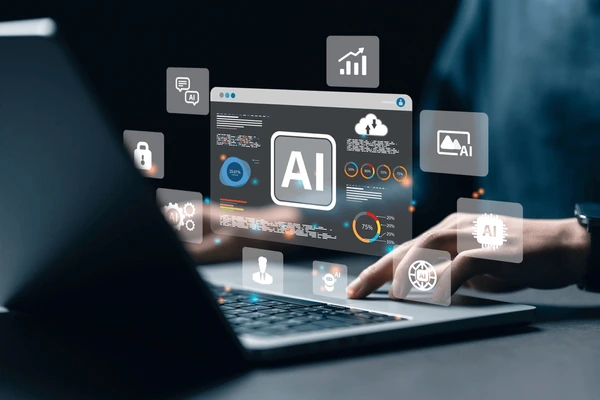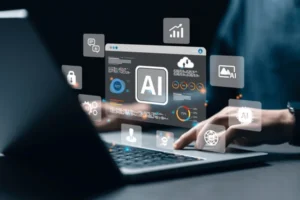The Ethical Dilemma
of AI Inbreeding

Artificial Intelligence (AI) has revolutionized various industries, bringing efficiency, innovation, and a plethora of possibilities. However, with the rapid development of AI technologies comes a concept that may not be as widely discussed: AI inbreeding. This term refers to the phenomenon where AI systems are developed or trained using outputs from other AI systems, potentially leading to a closed loop of knowledge and decision-making. While AI inbreeding might sound like a niche technical issue, it carries significant ethical, practical, and societal implications.
What is AI Inbreeding?
AI inbreeding occurs when new AI models are trained or influenced heavily by the outputs of existing AI systems. For example, if an AI system generates a dataset or a model that is then used as input for another AI system, and this process is repeated multiple times, the new AI model may end up being based more on AI-generated content than on original human-generated data.
This can lead to a narrowing of perspectives and a potential loss of diversity in the information and decision-making processes of AI systems. The risk is that AI systems might start to “learn” from a progressively smaller pool of data, reducing the robustness and accuracy of the AI models.
Risks and Challenges

One of the most significant risks of AI inbreeding is the potential loss of diversity in AI models. Just as genetic inbreeding in biology can lead to a lack of genetic diversity and increase the risk of inherited disorders, AI inbreeding can reduce the diversity of knowledge and perspectives within AI systems. This can lead to models that are less innovative and more prone to making mistakes or reinforcing biases.
If an AI model is trained using data or outputs from other AI systems that already contain biases, these biases can be perpetuated and even amplified. For instance, if an AI system trained on biased data is used to generate new training data for another AI system, the bias becomes more deeply embedded in the new system. This could lead to discriminatory practices and decisions, particularly in sensitive areas like hiring, criminal justice, or healthcare.
AI inbreeding could lead to the creation of AI systems that function within an “echo chamber,” where they continually reinforce the same ideas, assumptions, and decisions without introducing new or diverse inputs. This can create a feedback loop that limits the system’s ability to adapt to new information or changing circumstances, leading to outdated or incorrect decisions.
As AI systems become more autonomous and are increasingly relied upon to make decisions, there is a risk that human oversight might diminish. If AI systems are learning from other AI systems rather than from human-generated data, the ability of humans to understand, guide, or correct these systems could be compromised. This lack of transparency and accountability could have serious ethical and societal consequences.
Ethical Implications
The ethical implications of AI inbreeding are profound. As AI systems play a growing role in critical decision-making processes, from medical diagnoses to financial transactions, ensuring that these systems are accurate, unbiased, and transparent is crucial. AI inbreeding poses a threat to these principles by potentially creating AI models that are insular, biased, and difficult to understand or control.
There is also the question of responsibility. If an AI system makes a harmful decision based on biased data generated by another AI system, who is responsible? The original developers of the first AI model, the developers of the second model, or the organizations that implemented these systems? Addressing these questions requires a robust ethical framework that considers the complex interactions between AI systems.
Mitigating the Risks of AI Inbreeding
To mitigate the risks associated with AI inbreeding, several strategies can be employed:
Ensuring that AI systems are trained on diverse and representative datasets is crucial. This includes incorporating human-generated data and insights from various demographic, cultural, and socio-economic backgrounds.
Maintaining human oversight and involvement in the development and decision-making processes of AI systems can help prevent the over-reliance on AI-generated data. Human judgment is essential in identifying biases, validating outputs, and making ethical decisions.
Developing AI systems with transparency in mind can help build trust and understanding. This includes documenting the data sources, algorithms, and decision-making processes used in AI models. Additionally, establishing clear accountability mechanisms for AI systems can ensure that any harm caused by AI decisions is addressed.
Collaborating across disciplines—such as computer science, ethics, law, and social sciences—can help address the complex challenges of AI inbreeding. This interdisciplinary approach can lead to more robust, fair, and ethical AI systems.

Conclusion
AI inbreeding presents a unique and significant challenge in the development of AI technologies. As AI systems become increasingly interconnected and autonomous, the risks of reduced diversity, reinforced biases, and diminished human oversight grow. Addressing these risks requires a concerted effort to ensure that AI systems are built on diverse data, maintain human involvement, and are developed with transparency and accountability.
The ethical implications of AI inbreeding cannot be ignored. By acknowledging and addressing these challenges, we can work towards creating AI systems that are not only powerful and innovative but also ethical and fair. As AI continues to shape our world, it is crucial to ensure that it does so in a way that benefits all of humanity, rather than perpetuating the flaws of its own making.
Responsive Design: Bridging the Gap Between Web and Mobile

In today’s digital age, the divide between web and mobile platforms is rapidly shrinking, thanks to responsive design. This design approach ensures that websites and applications offer an optimal viewing experience across various devices, whether it’s a large desktop monitor or a compact smartphone screen.
What is Responsive Design?
Responsive design is a web development technique that allows a website to adapt to the size and orientation of the user’s screen. It involves the use of flexible grids, layouts, images, and CSS media queries. Instead of creating separate designs for different devices, responsive design ensures that a single website can adjust seamlessly, providing users with a consistent experience regardless of the device they use.
Why is Responsive Design Important?
With the increasing use of smartphones and tablets, it’s crucial for businesses to have a website that functions well on all devices. A responsive design improves user experience, which in turn can lead to higher engagement, reduced bounce rates, and increased conversion rates. Furthermore, search engines like Google prioritize mobile-friendly websites in their rankings, making responsive design a key factor in SEO strategies.
Bridging the Gap
Responsive design effectively bridges the gap between web and mobile by creating a unified experience. Users no longer have to struggle with zooming in on tiny text or navigating awkwardly through non-mobile-friendly sites. Instead, they can enjoy a smooth, intuitive experience that feels natural on any device.
The Future of Responsive Design
As technology continues to evolve, the principles of responsive design will remain critical. With the rise of new devices like smartwatches, foldable screens, and more, the need for adaptable and responsive designs will only grow. Businesses that embrace this approach will be better positioned to meet the needs of their users, regardless of how they access the web.
With its ability to analyze vast amounts of data and make decisions at incredible speeds, AI has become a cornerstone of modern technology. It is used in everything from personal assistants like Siri and Alexa to more complex systems in industries such as finance, automotive, and manufacturing.
AI’s impact on healthcare is particularly noteworthy. It enables early diagnosis of diseases, personalized treatment plans, and even robotic surgeries, improving patient outcomes significantly. In the automotive industry, AI drives innovation in autonomous vehicles, making them safer and more efficient.
However, the rise of AI also brings challenges, such as job displacement and ethical concerns. As AI systems become more capable, there is a growing need for regulations and guidelines to ensure they are used responsibly and for the benefit of society.
Despite these challenges, the future of AI looks promising, with endless possibilities to improve our quality of life and solve complex problems. As AI continues to evolve, it will undoubtedly play an even more significant role in shaping the world of tomorrow.
You Can Find Us On
Location:
Ruko Melawai, Blok C No. 8,
Taman Lembah Hijau, Lippo Cikarang,
Serang, Cikarang Selatan
Bekasi, 17550
Hours:
Monday – Friday: 08:00 – 17:00
Phone Numbers:
+62 218 990 5735 +62 878 878 777 78
Email:
admin@ajindotech.com
Copyright ajindotech.com 2024 – All Rights Reserved
AI: Transforming the Future

Artificial Intelligence (AI) is revolutionizing various aspects of our lives, from healthcare to entertainment. With its ability to analyze vast amounts of data and make decisions at incredible speeds, AI has become a cornerstone of modern technology. It is used in everything from personal assistants like Siri and Alexa to more complex systems in industries such as finance, automotive, and manufacturing.
AI’s impact on healthcare is particularly noteworthy. It enables early diagnosis of diseases, personalized treatment plans, and even robotic surgeries, improving patient outcomes significantly. In the automotive industry, AI drives innovation in autonomous vehicles, making them safer and more efficient.
However, the rise of AI also brings challenges, such as job displacement and ethical concerns. As AI systems become more capable, there is a growing need for regulations and guidelines to ensure they are used responsibly and for the benefit of society.
Despite these challenges, the future of AI looks promising, with endless possibilities to improve our quality of life and solve complex problems. As AI continues to evolve, it will undoubtedly play an even more significant role in shaping the world of tomorrow.
Copyright ajindotech.com 2024 – All Rights Reserved



